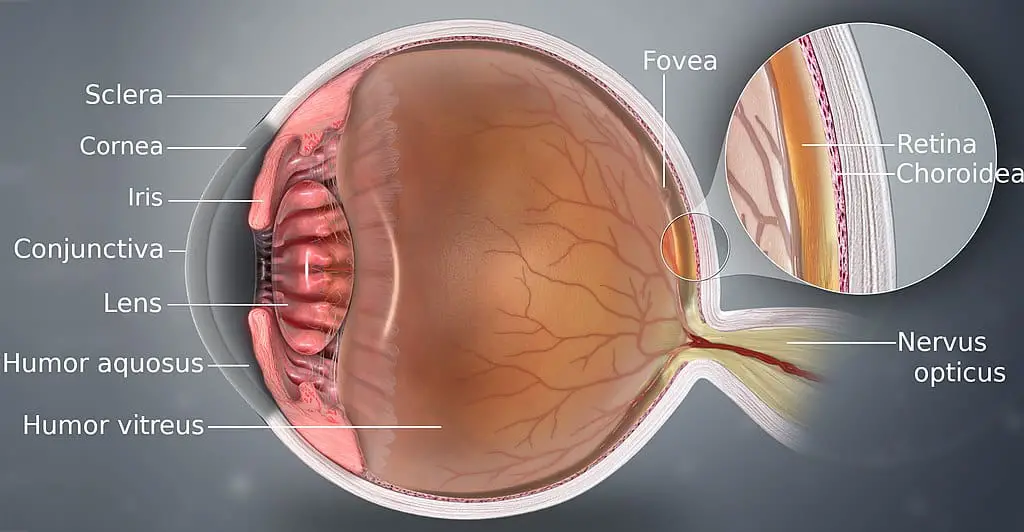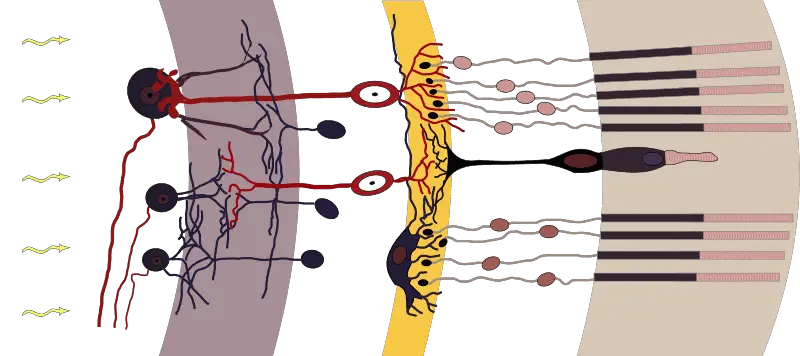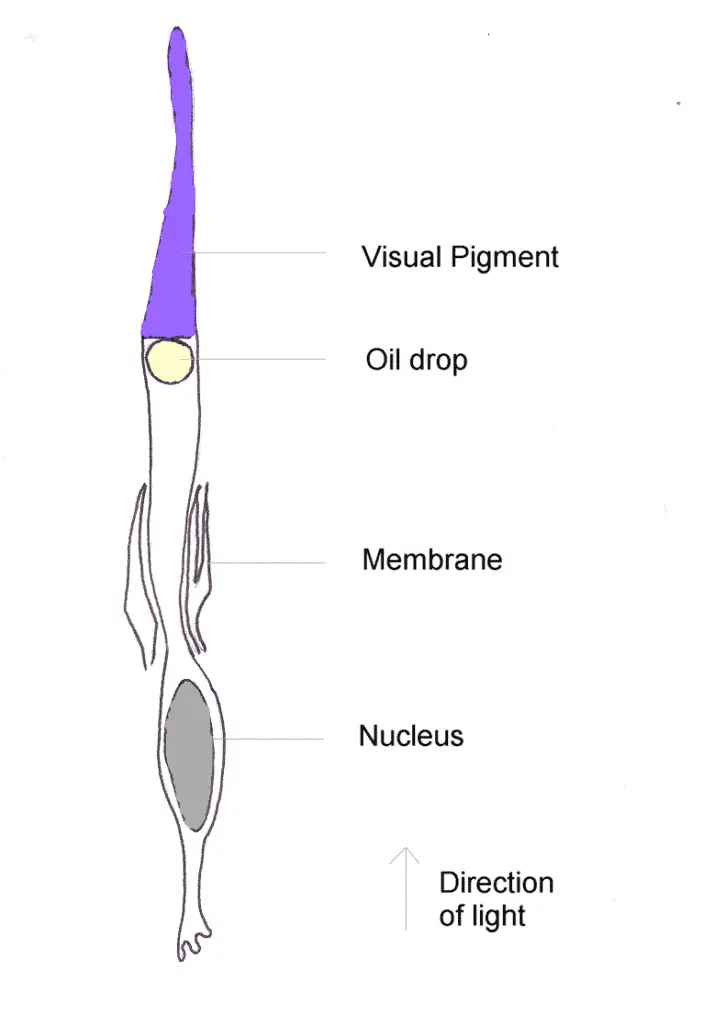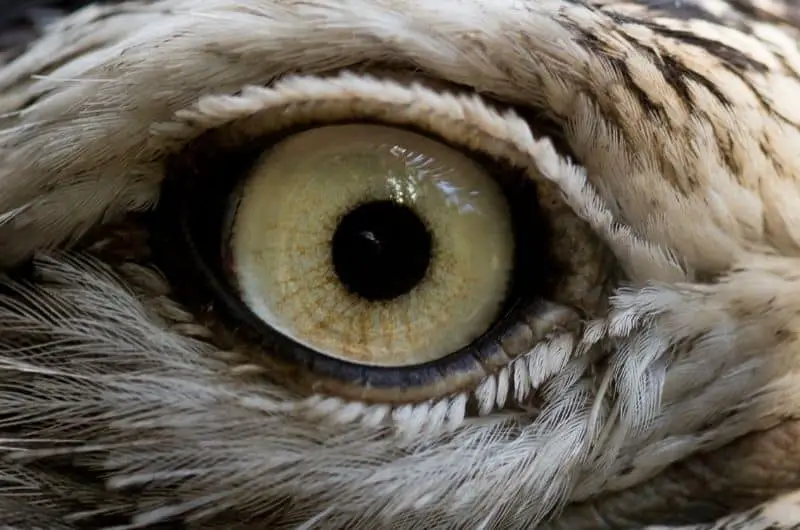It’s obvious that birds have eyes that look different from our own, but do they see the world differently from us also? There are surprising differences in the way birds see compared to us and not simply in the colors they see. Let’s dive into the world of avian vision and discover if birds see colour the same way we do.
Birds are able to see red, green, and blue in the same way we are. This is due to the cone cells in the eyes which are responsible for color vision. However, birds have one extra cone cell in their eyes that enables them to see into the Ultraviolet light spectrum. Humans cannot see UV light.
Let’s go inside the eye of a bird and see just how their incredible eyes work. We’ll compare them to human eyes and see just what differences make their vision so amazing.
Bird Eye Vs Human Eye
Below you can see a diagram of the structure of the human eye.

This diagram shows the structure of a bird’s eye.

On the surface, they appear very similar. They have much the same parts and the positioning of those parts is relatively the same. It’s at a cellular level though they begin to appear very, very different.
How Humans And Birds See Colour
In the Retina of our eyes and those of a bird, there are special cells that detect light and enable us to see. These are called rod and cone cells. Cone cells respond differently to light of different wavelengths which allows us to see colors. Rod cells function better in low light and are used in peripheral vision and are almost entirely responsible for night vision.
Learn about the digestive systems of birds in this article here on my site.

Fig_retine.png: Ramón y Cajalderivative work Fig retine bended.png: Anka Friedrich (talk)derivative work: vectorisation by chris 論, CC BY-SA 3.0 https://creativecommons.org/licenses/by-sa/3.0, via Wikimedia Commons
As I mentioned above, birds have one extra cone cell and this allows them to see UV light. This is especially helpful to birds for a number of reasons. Certain colors on birds’ feathers reflect UV light, making them stand out more from other birds. This may be how birds identify their own species and most likely helps when choosing a mate.
Birds such as the Kestral use their UV light-seeing skills to track prey. The phosphorous in their prey’s urine reflects UV light, leaving a glowing trail for the bird to follow.
In addition to this extra cone cell, birds also have a colored oil droplet in each cone cell. These oil drops act as filters and increase the number of colors a bird can make out. We can only make out red, green, and blue; all the colors we see are made up of some combination of each of those.

Jimfbleak, Public domain, via Wikimedia Commons
We can only imagine how incredibly colorful the world is to birds. However, it is not just the range of colors birds see that makes their vision so amazing…
How birds fly is also amazing. Discover how they do it in this article.
How Do Birds Navigate?
What if I told you that birds can actually see the magnetic field of the Earth? There have been recent discoveries that suggest this could actually be true?!

Our planet generates a magnetic field due to electric currents that run deep in the interior and high above the surface. We have used these magnetic currents to navigate around the Earth for centuries, they are the reason a compass needle points north (magnetic north).

Take a deep breath, things are about to get even more sciency!
It is thought birds can both see and navigate by the Earth’s magnetic field. In the retina of a bird’s eye is a protein called Cryptochrome. Cryptochrome can produce molecules called Radicals and these are affected by magnetic fields. They may see the magnetic field as a shadow in their vision.
Of course, we have no real way of knowing if this is true but scientists speculate that birds may see the magnetic field as a shadow in their vision and be able to follow it like a roadmap. This might explain how birds can migrate incredible distances and not get completely lost.
We also have cryptochrome in our eyes however, I don’t know about you but I can’t see the Earth’s magnetic field!
How Birds See Differently

Another way birds see differently from humans is in how their eyes focus, or how much of their field of view is in focus.
The Fovea is part of the Retina of the eye and has the most resolution; it is where your vision is most clear. We see focus mostly straight ahead. Birds of Prey see differently as they have 2 foveae; one helps them to focus far away while the other focuses on things close to the bird.
This is like having a zoom lens and a macro lens right there in your eye?! What a unique way of seeing!
Sea birds have a single fovea that runs in a strip across their entire retina. This helps them to see the horizon in crisp focus while they are flying along.
Discover why some birds fly in circles in this post here on my site.
One More Birds Eye Fact
The human eye is an incredible creation but it does have its flaws. Our vision can be obscured by the shadows of blood vessels in our eyes. This happens very quickly and only causes tiny variations in the direction of the light hitting our retinas; kind of like the way light flickers on your eyes when you drive your car through a forest on a sunny day.
Birds have this covered. They have a structure in their eye called the Pectin Oculi. It is a collection of blood vessels packed closely together. This provides the eye with all the nutrients it needs and eliminates the need for blood vessels in other areas of the eye.
The effect of this is a super-clear vision in rapidly changing light conditions. When a bird of prey is rocketing down through the trees to catch a rodent its vision stays 100% the whole time.
References
- Human Eye – Wikipedia
- Bird Vision – Wikipedia
- How Birds Really See The World – SciShow
- Animal Magnetism: How Animals Navigate – SciShow
- How quantum mechanics helps birds find their way – Nature Video

